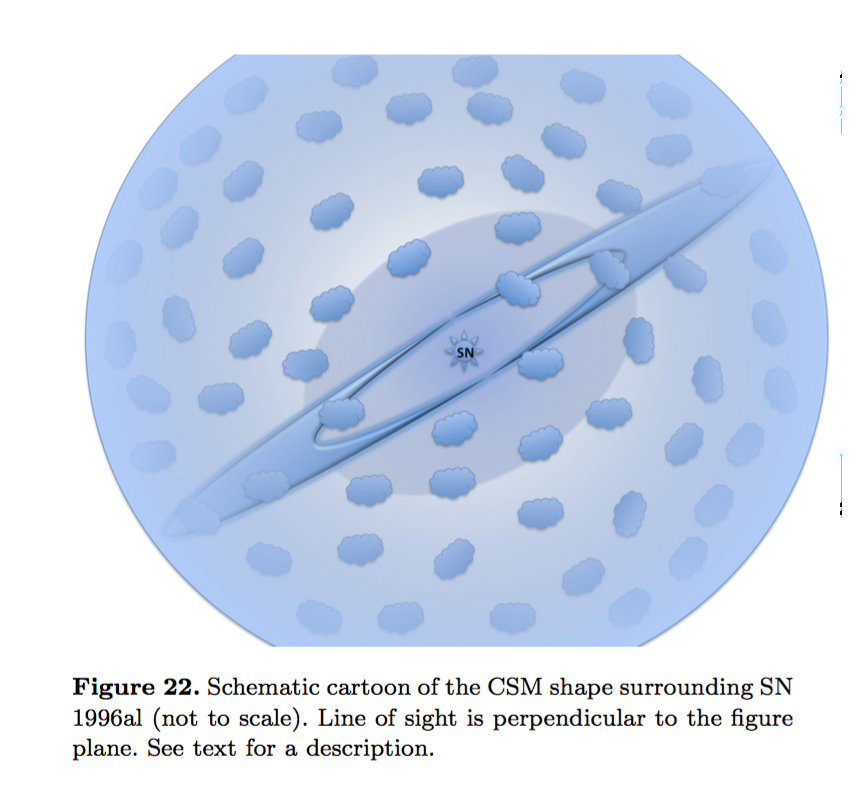Padova-Asiago Supernova Group
Highlights
The spectacular evolution of Supernova 1996al over 15 years: a low energy explosion of a stripped massive star in a highly structured environment
Benetti, S., et al. 2016, MNRAS 456,3296 (link to pdf)
Spectrophotometry of SN 1996al carried out throughout 15 years is presented. The early photometry suggests that SN 1996al is a Linear type-II supernova, with an absolute peak of MV ~18.2 mag. Early spectra present broad, asymmetric Balmer emissions, with super-imposed narrow lines with P-Cygni profile, and He I features with asymmetric, broad emission components. The analysis of the line profiles shows that the H and He broad components form in the same region of the ejecta. By day +142, the Halpha profile dramatically changes: the narrow P-Cygni profile disappears, and the Halpha is fitted by three emission components, that will be detected over the remaining 15 yrs of the SN monitoring campaign. Instead, the He I emissions become progressively narrower and symmetric. A sudden increase in flux of all He I lines is observed between 300 and 600 days. Models show that the supernova luminosity is sustained by the interaction of low mass (~1.15 Msun) ejecta, expelled in a low kinetic energy (~ 1.6 10^50 erg) explosion, with highly asymmetric circumstellar medium. The detection of Halpha emission in pre-explosion archive images suggests that the progenitor was most likely a massive star ( 25 Msun ZAMS) that had lost a large fraction of its hydrogen envelope before explosion, and was hence embedded in a H-rich cocoon. The low-mass ejecta and modest kinetic energy of the explosion are explained with massive fallback of material into the compact remnant, a 7 8 Msun black hole. 74
Benetti, S., et al. 2016, MNRAS 456,3296 (link to pdf)
Spectrophotometry of SN 1996al carried out throughout 15 years is presented. The early photometry suggests that SN 1996al is a Linear type-II supernova, with an absolute peak of MV ~18.2 mag. Early spectra present broad, asymmetric Balmer emissions, with super-imposed narrow lines with P-Cygni profile, and He I features with asymmetric, broad emission components. The analysis of the line profiles shows that the H and He broad components form in the same region of the ejecta. By day +142, the Halpha profile dramatically changes: the narrow P-Cygni profile disappears, and the Halpha is fitted by three emission components, that will be detected over the remaining 15 yrs of the SN monitoring campaign. Instead, the He I emissions become progressively narrower and symmetric. A sudden increase in flux of all He I lines is observed between 300 and 600 days. Models show that the supernova luminosity is sustained by the interaction of low mass (~1.15 Msun) ejecta, expelled in a low kinetic energy (~ 1.6 10^50 erg) explosion, with highly asymmetric circumstellar medium. The detection of Halpha emission in pre-explosion archive images suggests that the progenitor was most likely a massive star ( 25 Msun ZAMS) that had lost a large fraction of its hydrogen envelope before explosion, and was hence embedded in a H-rich cocoon. The low-mass ejecta and modest kinetic energy of the explosion are explained with massive fallback of material into the compact remnant, a 7 8 Msun black hole. 74
